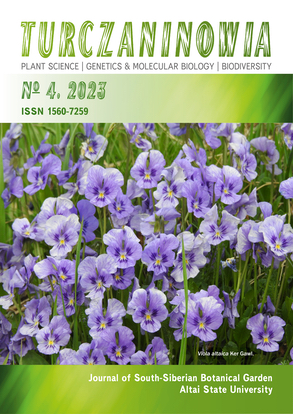Rediscovery of Rubus sikkimensis Hook. f. from Northeast India and lectotypification of its name
УДК 582.734.4:581.95(540.37)
Abstract
Rubus sikkimensis Hook. f. is an endemic species of eastern Himalaya, described from Sikkim by J. D. Hooker in 1849. Since then, the species was never collected from India until its rediscovery from Sikkim in 2019 after a gap of 170 years. Another collection from Tawang, Arunachal Pradesh, India, made by the author in 2021, is reported here as a new distributional record. A detailed description of the species with lectotype designation, photographs, and comparison with allied species are provided to facilitate its easy identification.
Downloads
Metrics
References
Boufford D. E., Siwakoti M., Pendry C. A. 2011. Rubus L. In: M. F. Watson, S. Akiyama, H. Ikeda, C. A. Pendry, K. R. Rajbhandari, K. K. Shrestha (eds.). Flora of Nepal. Edinburgh, U.K.: The Royal Botanic Garden. Pp. 327–346.
Carter K. A., Liston A., Bassil N. V., Alice L. A., Bushakra J. M., Sutherland B. L., Mockler T. C., Bryan D. W., Hummer K. E. 2019. Target capture sequencing unravels Rubus evolution. Front. Plant Sci. 10: 1615. DOI: 10.3389/ fpls.2019.01615
Daubeny H. A. 1996. Brambles. In: J. Janick, J. N. Moore (eds.). Fruit breeding: Vol. II. Vine and small fruit crops. New York, NY: Wiley. Pp. 109–190.
Focke W. O. 1910–1911, 1914. Species Ruborum. Monographiae generis Rubi Prodromus. Biblioth. Bot. (Stuttgart; E. Schweizerbart, New York, USA) 17 (72, part I): 1–120 (1910); 17 (72, part II)): 121–223 (1911); 19 (83): 224–488 (1914).
Gupta C. 2019. Taxonomic revision of the genus Rubus L. (Rosaceae) in India. Ph.D. Thesis. West Bengal: University of Calcutta. 255 pp.
Gupta C., Dash S. S. 2018. A new species of Rubus (Rosaceae) from Arunachal Pradesh, India. Blumea 63: 26–30.
Gupta C., Kumar V. 2023. Rubus dhauladharensis (Rosaceae), a new species from Himachal Pradesh, India. Annales Botanici Fennici 60(1): 265–270.
Hooker J. D. 1878. Rosaceae. In: J. D. Hooker (ed.). The Flora of British India. Vol. 2. London, UK. Pp. 307–388.
Jennings D. L. 1988. Raspberries and Blackberries: Their Breeding, Diseases and Growth. London: Academic Press. 230 pp.
Long D. G. 1987. Rubus L. In: A. J. C. Grierson, D. G. Long (eds.). Flora of Bhutan. Vol. 1(3). Edinburgh, UK: Royal Botanic Garden. Pp. 543–562.
Lu L., Boufford D. 2003. Rubus. In: Z. Wu, P. Raven, D. Hong (eds.). Flora of China. Vol. 9. Beijing, China: Science Press; St. Louis, USA: Missouri Botanical Garden Press. Pp. 195–285.
POWO [2023]. Plants of the World Online. Kew: Facilitated by the Royal Botanic Gardens. URL: http://www. plantsoftheworldonline.org/ (Accessed 22 May 2023).
Turland N. J., Wiersema J. H., Barrie F. R., Greuter W., Hawksworth D. L., Herendeen P. S., et al. (eds.). 2018. International Code of Nomenclature for algae, fungi, and plants (Shenzhen Code) adopted by the Nineteenth International Botanical Congress Shenzhen, China, July 2017. Glashütten (Regnum Vegetabile, vol. 159). DOI: 10.12705/Code.2018
Turczaninowia is a golden publisher, as we allow self-archiving, but most importantly we are fully transparent about your rights.
Authors may present and discuss their findings ahead of publication: at biological or scientific conferences, on preprint servers, in public databases, and in blogs, wikis, tweets, and other informal communication channels.
Turczaninowia allows authors to deposit manuscripts (currently under review or those for intended submission to Turczaninowia) in non-commercial, pre-print servers such as ArXiv.
Authors who publish with this journal agree to the following terms:
- Authors retain copyright and grant the journal right of first publication with the work simultaneously licensed under a Creative Commons Attribution License that allows others to share the work with an acknowledgement of the work's authorship and initial publication in this journal.
- Authors are able to enter into separate, additional contractual arrangements for the non-exclusive distribution of the journal's published version of the work (e.g., post it to an institutional repository or publish it in a book), with an acknowledgement of its initial publication in this journal.
- Authors are permitted and encouraged to post their work online (e.g., in institutional repositories or on their website) prior to and during the submission process, as it can lead to productive exchanges, as well as earlier and greater citation of published work (See The Effect of Open Access).





